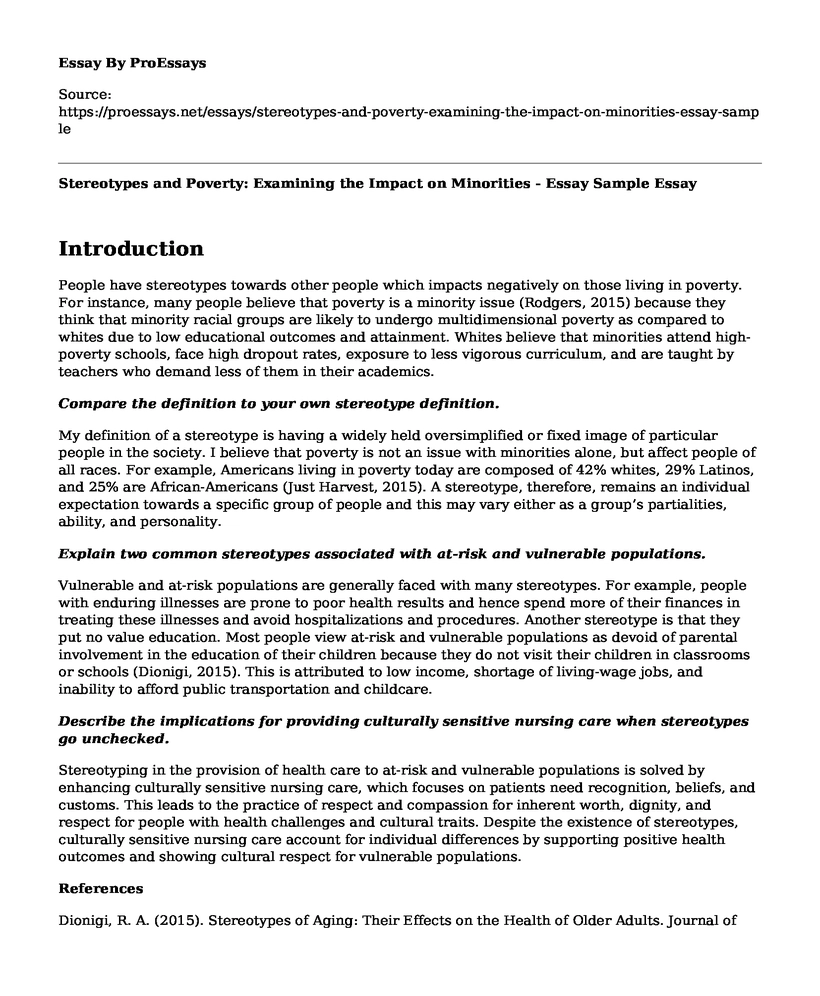Introduction
People have stereotypes towards other people which impacts negatively on those living in poverty. For instance, many people believe that poverty is a minority issue (Rodgers, 2015) because they think that minority racial groups are likely to undergo multidimensional poverty as compared to whites due to low educational outcomes and attainment. Whites believe that minorities attend high-poverty schools, face high dropout rates, exposure to less vigorous curriculum, and are taught by teachers who demand less of them in their academics.
Compare the definition to your own stereotype definition.
My definition of a stereotype is having a widely held oversimplified or fixed image of particular people in the society. I believe that poverty is not an issue with minorities alone, but affect people of all races. For example, Americans living in poverty today are composed of 42% whites, 29% Latinos, and 25% are African-Americans (Just Harvest, 2015). A stereotype, therefore, remains an individual expectation towards a specific group of people and this may vary either as a group’s partialities, ability, and personality.
Explain two common stereotypes associated with at-risk and vulnerable populations.
Vulnerable and at-risk populations are generally faced with many stereotypes. For example, people with enduring illnesses are prone to poor health results and hence spend more of their finances in treating these illnesses and avoid hospitalizations and procedures. Another stereotype is that they put no value education. Most people view at-risk and vulnerable populations as devoid of parental involvement in the education of their children because they do not visit their children in classrooms or schools (Dionigi, 2015). This is attributed to low income, shortage of living-wage jobs, and inability to afford public transportation and childcare.
Describe the implications for providing culturally sensitive nursing care when stereotypes go unchecked.
Stereotyping in the provision of health care to at-risk and vulnerable populations is solved by enhancing culturally sensitive nursing care, which focuses on patients need recognition, beliefs, and customs. This leads to the practice of respect and compassion for inherent worth, dignity, and respect for people with health challenges and cultural traits. Despite the existence of stereotypes, culturally sensitive nursing care account for individual differences by supporting positive health outcomes and showing cultural respect for vulnerable populations.
References
Dionigi, R. A. (2015). Stereotypes of Aging: Their Effects on the Health of Older Adults. Journal of Geriatrics, 2015, 1–9. DOI: 10.1155/2015/954027
Just Harvest (2015). Action against hunger: just the facts: Poverty myths & stereotypes. https://www.justharvest.org/wp-content/uploads/2015/07/Just-Harvest-Poverty-Myths-Stereotypes-fact-sheet.pdf.
Rodgers, H. R. (2015). American poverty in a new era of reform. London; New York: Routledge, Taylor et Francis Group.
Cite this page
Stereotypes and Poverty: Examining the Impact on Minorities - Essay Sample. (2023, Aug 27). Retrieved from https://proessays.net/essays/stereotypes-and-poverty-examining-the-impact-on-minorities-essay-sample
If you are the original author of this essay and no longer wish to have it published on the ProEssays website, please click below to request its removal:
- Terrorist Attack on the Eagles of Death Metal Concert
- Essay Sample on Gun Violence in Baltimore
- Feminist's Issue in Hedda Gabler Essay
- Distracted Driving in Florida State Essay
- Essay Example on Fast Food and Beverage Industry: Harms of Targeting Kids with Obesity
- Domestic Violence: Adverse Impact on Children's Behavioural Development - Essay Sample
- Paper Example on Perinatal Drug Abuse: Neonatal Drug Withdrawal Risk







